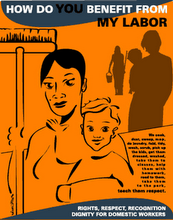Tuesday, January 30, 2007
Study: Low-income rates among immigrants entering Canada
The economic situation of new immigrants to Canada showed no improvement after the turn of the millennium — despite the fact that they had much higher levels of education and many more were in the skilled immigrant class than a decade earlier, according to a new report.
The report examines the economic welfare of immigrant families, not just individuals. It assesses their economic situation since 2000, and the extent of "chronic" low income, and the impact of changes in education and skill classes on their economic well-being since 1993.
In 2002, low-income rates among immigrants during their first full year in Canada were 3.5 times higher than those of Canadian-born people. By 2004, they had edged down to 3.2 times higher.
These rates were higher than at any time during the 1990s, when they were around three times higher than rates for Canadian-born people.
The increase in low income was concentrated among immigrants who had just recently entered the country, that is, they had been here only one or two years. This suggests they had more problems adjusting over the short-term during the years since 2000.
One possible explanation may have been the downturn in the technology sector after 2000. The proportion of recent immigrants who were in occupations in information technology and engineering rose dramatically over the 1990s.
The report found that overall, the large increase in educational attainment of new immigrants, and the shift to the skilled class immigrant, had only a small impact on their likelihood of being in low income.
Note to readersData for this study came from a database that combines the Longitudinal Administrative Database (LAD) and the Longitudinal Immigration Database (IMDB). The LAD is random, 20% sample of all taxfilers and their families. Individuals selected for the LAD are linked across years to create a longitudinal profile of each individual. The IMDB contains immigrant landing record and annual tax information for immigrants who have arrived since 1980. The LAD-IMDB allows comparisons of known immigrants and other Canadian taxfilers. Outcomes for immigrants are ideally compared to those of the Canadian-born population. However, in the LAD-IMDB it is not possible to separate immigrants in Canada for more than 10 years from the Canadian born. As a result, this study created a "comparison group" consisting of the Canadian-born, plus immigrants who had been in Canada for more than 10 years. Their economic outcomes typically more closely resemble those of the Canadian-born than is the case for more recent immigrants. The report compares results for recent immigrants to those of individuals in the comparison group of the same age. The analyses include individuals aged 20 years and over for calculating cross-sectional low-income rates. In analyses of low-income (entry, exit, and chronic low-income rates), only those aged 25 to 54 at landing were included. In this study, low income is defined as family income below 50% of median income of the total population, adjusted for family size. The low-income cutoff is $26,800 (in 2003 constant dollars) for a family of four. |
In 1993, the selection system for immigrants was modified to attract more highly educated immigrants, as well as more in economic "skilled" classes.
As a result, among new immigrants aged 15 and older, the proportion with university degrees rose from 17% in 1992 to 45% in 2004. And the share in the economic skilled immigrant class increased from 29% to 51%.
Probability of entering and leaving a period of low income
The probability of entering a period of low income was very high for immigrants during their first year in Canada. It ranged from 34% to 46% depending upon their year of arrival.
However, if immigrants did not enter a period of low income during their first year, the likelihood of that happening fell substantially to 10% or less for subsequent years in Canada.
The result was that for immigrants who arrived during the early 1990s, about 65% entered low income at some time during their first 10 years in Canada. Of these, two-thirds did so during their first year.
If arriving immigrants escaped low income in their first full year, their chances of remaining out of low income were quite high.
For many, the first low-income spell was quite short. Between 34% and 41% exited after one year, depending on arrival cohorts. About one-third remained in their first period of low income after three years. However, even if they left a period of low income, it was possible they could re-enter at some later point.
The rapid increase throughout the 1990s in the share of arriving immigrants who were highly-educated and in the skilled economic class might have been expected to lower the chance of entering low-income, and increase the likelihood of leaving. This is because the more highly educated and "economic class" immigrants traditionally did better in the labour market.
However, the report shows that these changes had relatively little impact on entry and exit rates throughout the 1990s.
This was partly because there was only a small difference in low-income entry and exit patterns between immigrants who were more educated, and those with less education. Furthermore, by the early 2000s, immigrants in the skilled economic class were more likely to enter low income than their family-class counterparts.
For example, for the group that arrived in 2003, the probability of entering low income during the first year in Canada was about 2.3 percentage points lower than it would have been had the educational and class characteristics of the arriving immigrants not changed.
In contrast, the business cycle had a much bigger impact. The entry rate into low income fell by about 11.5 percentage points between the peak and the trough of the cycle.
Nearly a fifth of recent immigrants were in chronic low income
For the purposes of this report, "chronic" low income was defined as being in low income at least four of the first five years in Canada.
The report found that nearly one in five (18.5%) of recent immigrants who arrived between 1992 and 2000 were in low income at least four years during their first five years in Canada. This was more than twice the corresponding rate of around 8% among Canadian-born people.
For the group that arrived in 1993, the five-year chronic low-income rate was 20.5%. For those who arrived in 2000, it had declined to 16.2% as the economy improved.
There were two possible reasons for the decline: the more favorable labour market-related characteristics of immigrants entering in the late 1990s, and improving economic conditions (business cycle). The report found immigrant characteristics accounted for virtually none of the improvement; improving economic conditions accounted for the majority.
Overall, the large rise in educational attainment of entering immigrants and the shift to the skilled class immigrant had only a very small effect on poverty outcomes as measured by the probability of entry, exit and chronic rates.
This is because by the early 2000s, skilled class entering immigrants were actually more likely to enter low income and be in chronic low income than their family class counterparts.
In addition, the small advantage that the university educated entering immigrants had over, say, the high school educated in the early 1990s had largely disappeared by 2000, as the number of highly educated immigrants rose.
Changes in entering immigrant characteristics did alter the composition of the immigrants in chronic low income.
Among those who arrived in 2000, 52% of those in chronic low income were skilled economic immigrants. About 41% had university degrees, up from 13% in the 1993 cohort.
The research paper "Chronic low income and low-Income dynamics among recent immigrants" is now available as part of the Analytical Studies Branch Research Paper Series (11F0019MIE2007294, free) from the Publications module of our website.
Related studies from the Business and Labour Market Analysis Division can be found under Update on Analytical Studies Research (11-015-XIE, free) on our website.
For more information, or to enquire about the concepts, methods or data quality of this release, contact Garnett Picot (613-951-8214), Business and Labour Market Analysis Division.















